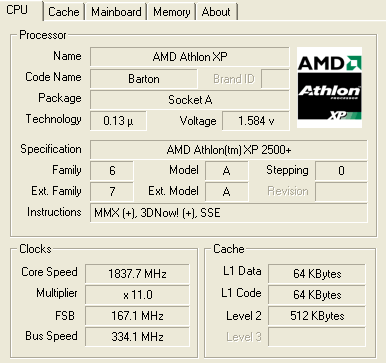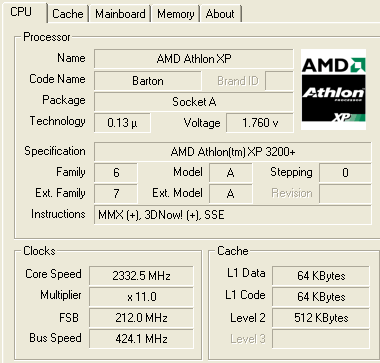Overclocking tests
Overclocking
The very reason why we're even conducting this experiment is to see if the AQXEA Barton XP2500s are anywhere near as good as XP1700 JIUHBs when it comes to running past rated speeds. The standard 1.65v operating voltage doesn't instill a great deal of confidence, so all we have to go on is forum users' reports that this particular stepping is rather good.

The CPU-Z shot above shows the AQXEA XP2500+ Barton in standard, unspectacular form. A slight FSB overclock puts the running speed at 1837.7MHz. Please note that CPU-Z reports chipset and not VCore voltage.
Initial overclocking tests were undertaken using just FSB increases. The sample didn't think much of 180FSB (1980MHz) and 190FSB came and went without having to adjust the CPU's voltage. That's a running speed of 2090MHz, folks, and faster than a stock XP2800; a processor that costs twice as much. In fact, hitting the magical 200FSB mark, thereby making this CPU a pseudo £340 XP3200+ CPU, wasn't all that great a problem. Just sit back and think of that for a second or two. A £70 CPU with a similar quality of core found on the vastly more expensive XP3200+. What's more, with the XP2500+ sharing the same 11x multiplier, there is no real-world difference between the two. Compare that with Intel's massive FSB-clocking 2.4Cs. They can never be directly compared to models higher up in the range. Multiplier locking, fortunately for enthusiasts, is still not easy to implement on AMD's CPUs.
Our cooling, consisting of a Taisol 760 (modified with two 60mm 25CFM fans), is nothing special. Many enthusiasts now use larger heatsinks with 80mm fans as standard, so the results obtained here should be repeatable by many. As we're approaching this review from an average enthusiast's point of view, we felt that raising the Vcore to 1.7v load (set to 1.775v in BIOS) and upping the FSB above 200MHz was the way to go. Further, we weren't looking for a one-off benchmark speed that would fail long-term tests. We wanted a speed that would be as stable as a stock XP2500+. After a few hits and misses, lots of Toast, 3DMark 2001SE and Pifast running, we settled on the speed highlighted by CPU-Z below.

Absolutely stable. It took everything we could throw at it. The FSB was raised to a modest 212MHz, thereby highlighting an overclocked nForce2 Ultra 400 board. Memory timings were kept at the performance-enhancing 2-6-2-2. The CPU would go as high as 2400MHz but it would occasionally crash unexpectedly. CPU-Z seems to think this is a standard XP3200+. We've yet to find a utility, including WCPUID, that keeps the original AMD XP CPU name when it's overclocked heavily.
A ~27% overclock with just a touch more CPU voltage. It's kind of hard to complain at that, especially when the CPU costs £70 in the first place. Is this the new JIUHB ?. No, but it's damn good anyway. If this is an indication of just how most high AQXEA Barton 2500s can go, one questions the need to buy the bank-breaking XP3200 CPU. A little overclocking knowledge will help you save £££s.
We'll now go through our standard benchmarking suite and see how a standard XP2500+ compares to this overclocked monster. We'll add in the XP2800+, XP3200+, and P4 3.2GHz for an all-around comparison. Hold on to your hats.









